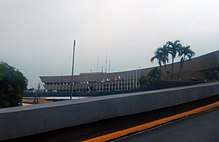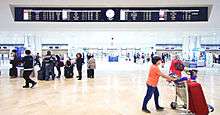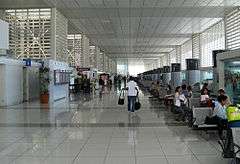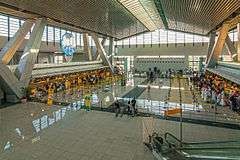Terminals of Ninoy Aquino International Airport
Ninoy Aquino International Airport in Manila, Philippines has four passenger terminals with a total of 66 gates. The terminals are served by a shuttle bus. Unlike other airports which do not have physical airside connections between any terminal, NAIA's terminals are built on separate lots in the same site and airside shuttle buses between terminals are also provided for passengers with connecting flights. In addition to these terminals, there are cargo facilities at the airport. A heliport is located on a lot between Terminals 2 and 4, near Nayong Pilipino.
Terminal 1


Terminal 1 (also known as Ninoy Aquino Terminal) has an area of 67,000 square metres (720,000 sq ft) and was opened in 1981. It is the first higher-capacity airport terminal in the Philippines and the second oldest-terminal in the NAIA complex after Terminal 4, or the Manila Domestic Passenger Terminal. With the airport complex located along the border between the cities of Pasay and Parañaque, Terminal 1, along with the main cargo terminal, are the only structures to be under the latter city's jurisdiction.
The terminal originally had a design capacity of 4.5 million passengers per year,[1] but it was further expanded to accommodate 6 million passengers.[2] Terminal 1 is currently used by numerous major international airlines, including Philippine Airlines, China Airlines, China Southern Airlines, Malaysia Airlines, Vietnam Airlines, Japan Airlines, Korean Air, Royal Brunei Airlines, and Saudia.[3][4]
Early years
Following the destruction of the original structure of Manila International Airport by a fire on January 22, 1972, a slightly smaller terminal, designed by Philippine National Artist for Architecture, Leandro Locsin, Sr. and his firm L.V. Locsin and Associates, was built to replace it. This airport terminal would serve as the main terminal of Manila International Airport from that year until 1981.
Conception
The development of the Manila International Airport was approved through the promulgation of Executive Order No. 381. In 1973, a feasibility study and airport master plan were completed by Airways Engineering Corporation through a US$29.6 million loan from the Asian Development Bank.[5] The Detailed Engineering Design of the New Manila International Airport Development Project was done by Renardet-Sauti, Transplan, and F. F. Cruz Consultant while the terminal's Detailed Brutalist Architectural Design was prepared by Leandro Locsin's L.V. Locsin and Associates.[6]
In 1974, the detailed designs were adopted by the Philippine Government. The designs were subsequently approved by the Asian Development Bank on September 18, 1975. The government chose an area close to the original site of the former Manila Airport, deciding on an area of land governed by Parañaque City, which was at the time a municipality of Metro Manila. Actual work on the terminal began during the second quarter of 1978.
Opening
The terminal was completed in 1981 and began operations in 1982. On April 2, 1982, a PAL Boeing 747-200B arriving from San Francisco via Honolulu became the first aircraft to dock at the terminal. During its opening, NAIA Terminal 1 was viewed as one of the world's most modern airports.
Assassination of Benigno, Aquino Jr.
China Airlines Flight 811 was a regularly scheduled flight from Taipei to Manila. On August 21, 1983, the flight utilized a Boeing 767-200 with the registration B-1836. Onboard this flight was Filipino politician Benigno S. Aquino, Jr., known by the nickname, Ninoy, who used a forged passport with the name "Marcial Bonifacio" for the final leg of his trip to the Philippines to avoid identification. Upon landing in Manila, the aircraft docked at Gate 8 (present-day Gate 11). Aviation Security Command (AVSECOM) personnel escorted Aquino out of the plane to the tarmac where a van owned by the agency awaited him. A single gunshot was heard, which was then identified as the shot that killed Aquino. Several shots burst out, killing the alleged assassin, Rolando Galman. Seconds later, a barrage of gunfire erupted, causing chaos in the plane, the tarmac, and the terminal. The bodies of Aquino and Galman lay on the tarmac; Aquino's body was loaded onto the van, which then sped away.
Ironically, Flight 811 was the same flight number that had been involved in an accident in 1980 at the same airport, albeit with a different aircraft used (a Boeing 707). Four years after Aquino's assassination in 1983, the airport was given its present name by virtue of Republic Act No. 6639.
Presently, a body mark of Aquino's assassination is on display at the departure parking lot. The spot at Gate 8 where he was killed has a memorial plaque.
Capacity breach
In 1989, a Master Plan Review recommended the construction of two new terminals (NAIA 2 and NAIA 3), as well as many other facility improvements.[6]
In 1991, the terminal reached capacity when it registered a total passenger volume of 4.53 million. Since 1991, the terminal has been over capacity and has been recording an annual average growth rate of 11%,[6] but improvements to the airport increased its capacity to 6 million passengers yearly.[2]
The terminal today
The terminal currently serves foreign carriers operating in Manila, except for All Nippon Airways, Cathay Pacific, Delta Air Lines, Emirates, KLM, Qantas, Qatar Airways, Singapore Airlines, Turkish Airlines, and United Airlines, which uses Terminal 3. It also serves Philippine Airlines flights to and from Toronto, Vancouver, New York, Auckland, Phnom Penh, Hanoi and the Middle East, except Dubai flights.[7][8]
Compared to international terminals in other Asian countries, NAIA 1 has been consistently ranked at the bottom due to limited and outdated facilities, poor passenger comfort, and crowding due to operating above designed capacity.[9] From 2011 to 2013, NAIA 1 was ranked first on the lists of Asia's worst and the world's worst airports by the travel website "The Guide to Sleeping In Airports".[10]
Transport authorities planned to give NAIA 1 a makeover; the plans were approved by President Benigno Aquino III. The makeover and upgrade includes the expansion of the arrival area, the addition of parking spaces, and the improvement of other terminal facilities.[11] The Transportation and Communications Department previously announced that as soon as Terminal 3 becomes fully operational, NAIA 1 was eyed by Cebu Pacific with the intention rehabilitating the terminal into an "Airport City" and serve as an exclusive terminal for their aircraft.[12]
On January 23, 2014, NAIA 1 started the process of upgrading and modernizing the 32-year-old passenger terminal building, planned to be finalized and operational by May 2015.[13][14] The renovation project was divided into six phases and had 40 percent completion on December 16, 2014.[15] The project included the installation of buckling restrained braces to strengthen the structural integrity of the building, as well as a facelift in the interior design of the terminal.[16] From August 1 to October 1, 2014, five international airlines—Delta Air Lines, KLM, Emirates, Singapore Airlines, and Cathay Pacific—were transferred to Terminal 3 in an effort to decrease the congestion of the terminal.[17] On October 28, 2018, United Airlines and Qantas were also relocated to Terminal 3.[18] Qatar Airways was also relocated to Terminal 3 on December 1, 2018, while Turkish Airlines was transferred to Terminal 3 on January 1, 2019.[19]
Airlines and destinations
Terminal 2 (Centennial Terminal)

Terminal 2 (NAIA-2) also known as Centennial Terminal, has an area of 75,000 square metres (810,000 sq ft), and is located at the Old MIA Road. It began construction in December 1995 and was inaugurated on May 1, 1999[20] and began operations in 1999. It has been named the Centennial Terminal in commemoration of the centennial year of the declaration of Philippine independence. The terminal was originally designed by Aéroports de Paris to be a domestic terminal, but the design was later modified to accommodate international flights.[21] It has a capacity of 2.5 million passengers per year in its international wing and 5 million in its domestic wing. It is able to be modified to accommodate nine million passengers per year if needed.[21]
Terminal 2 is exclusively used by Philippine Airlines and PAL Express for both its domestic and international flights. It is divided into two wings: the North Wing, for international flights, and the South Wing, which handles domestic operations. It currently has 12 jet bridges. There are several cafes and restaurants in the Terminal post-security. There is also a small duty-free section in the north wing. The need for two more terminals was proposed by a Master Plan Review of the Airport that was undertaken in 1989 by Aéroports de Paris (ADP). The study was facilitated by means of a grant from the French Government. The review cost 2.9 million French francs and was submitted to the Philippine Government for evaluation in 1990.[6]
In 1991, the French government granted a 30 million franc soft loan to the Philippine government, which was to be used to cover the Detailed Architectural and Engineering Design of the NAIA Terminal 2. ADP completed the design in 1992 and in 1994, the Japanese Government granted an 18.12 billion yen soft loan to the Philippine Government to finance 75% of the terminal's construction costs and 100% of the supervision costs. Construction of the Centennial Terminal began on December 11, 1995, and was formally turned over to the government of the Philippines on December 28, 1998. The terminal became fully operational by 1999.[22]
In August 2014, DOTC formally announced the plan of expanding of Terminal 2. The plan also considers to build a structure interconnecting Terminals 1 and 2.[23] It also includes the demolition of the unused Philippine Village Hotel complex beside the terminal awaiting the fixing of certain issues.[24] A fuel depot located between the terminals will be transferred to the demolished area to give way for the expansion.[25] The 26 comfort rooms are being renovated, in which 16 are located in a passenger movement area.[26] 4 of the 7 Air handling units are being repaired and 21 additional units are expected to be installed to improve the temperature in the Terminal.[27]
Terminal 3

Terminal 3 (NAIA-3) is the newest and largest terminal in the NAIA complex. Construction started on it in 1997. Since construction, the terminal has been at the center with legal battles, red tape, and arbitration cases in both the United States and Singapore, as well as technical and safety concerns which delayed its opening several times.[28] Terminal 3 is built on a 63.5-hectare (157-acre) lot that sits on Villamor Air Base. The terminal building has a total floor area of 182,500 square metres (1,964,000 sq ft) and has a total length of 1.2 kilometres (0.75 mi). A four-level shopping mall connects the terminal and parking buildings. The parking building has a capacity of 2,000 cars and the outdoor parking area has a capacity of 1,200 cars. The terminal is capable of servicing 33,000 passengers daily at peak or 6,000 passengers per hour.[29] A 220-meter long footbridge that opened in April 2017, known as Runway Manila, connects the terminal with Newport City. The bridge contains moving walkways and can accommodate about 2,000 persons at any given time.[30]
Its apron area has a size of 147,400 square metres (1,587,000 sq ft). The terminal has 34 jet bridges and 20 contact gates with the ability of servicing 28 planes at a time. The terminal has 70 flight information terminals, 314 display monitors, and 300 kilometres (190 mi) of fiber optic I.T. cabling. It also has 29 restroom blocks. The departure area has five entrances all equipped with X-ray machines with the final security check having 18 X-ray machines. Its baggage claim has 7 large baggage carousels, each with its own flight display monitor.[21]
The terminal officially opened to selected domestic flights from July 22, 2008 (initially Cebu Pacific only, then Philippine Airlines' subsidiaries Air Philippines and PAL Express), with Cebu Pacific international flights using it from August 1, 2008.[31] All international operations, except for those from PAL, are intended to operate from Terminal 3 in the future, originally proposed to move in fourth quarter of 2010,[32] however domestic carriers Cebu Pacific and PAL Express (then Air Philippines and became Airphil Express) remained the only tenants for the first two years of its operation. The vast majority of international flights still operate from Terminal 1, but All Nippon Airways became the first foreign-based carrier to operate out of Terminal 3 starting February 27, 2011.[33]
The terminal underwent a rehabilitation under the contractor Takenaka Corp. of Japan to improve its facilities and utilize the whole terminal. Previously, it only operated at half of its capacity awaiting the completion of the remaining system works.[34] The terminal became fully operational on August 1, 2014, leading to the transfer of five international airlines to Terminal 3 to ease congestion at Terminal 1 starting with Delta Air Lines on that day,[17] followed by KLM on August 4,[35] Emirates on August 15,[17] Singapore Airlines on September 1,[35] and Cathay Pacific on October 1.[35][36] Both United Airlines and Qantas are relocated to Terminal 3 from Terminal 1 on October 28, 2018.[37] Middle Eastern carriers Qatar Airways was also relocated to Terminal 3 on December 1, 2018, while Turkish Airlines was also transferred to Terminal 3 on January 1, 2019.[19]
Terminal 4 (Manila Domestic Passenger Terminal)
Terminal 4[38] named as Manila Domestic Passenger Terminal, and still known as the Old Domestic Terminal, is the oldest of the four existing terminals, having been built in 1948. It is host to all domestic flights within the Philippines that are operated by Cebgo, among others. There are no jet bridges and passengers walk to and from the aircraft or are occasionally bussed. Twenty-six check-in counters are located in the terminal. The departure hall has the seating capacity for 969 people at a time. Several food stores and a book and magazine stall are also available. Five baggage carousels are located in the terminal while domestic airline offices, banks, restaurants and a grocery store are also located right beside the domestic passenger terminal.[39] The Domestic Terminal is on the old Airport Road near the north end of Runway 13/31. An old hangar has since been annexed to the terminal.
See also
References
- TERMINAL 1 Archived October 14, 2007, at the Wayback Machine
- "About NAIA Terminal 1". 125.60.203.88.
- "NAIA Terminal 1". www.manila-airport.net. Retrieved 2019-07-09.
- "Manila Airport – NAIA (MNL): Airlines". www.manila-airport.net. Retrieved 2019-07-09.
- "LN0164-PHI: Manila International Airport Development". Asian Development Bank. Retrieved August 25, 2014.
- Airport : Terminal 1 Manila International Airport Authority Archived April 14, 2006, at the Wayback Machine Accessed September 7, 2006
- "Several PAL Mid-East flights to transfer to T1". Philippine Airlines. June 27, 2017. Retrieved July 9, 2017.
- https://www.philippineairlines.com/TravelInformation/BeforeYouFly/AtTheAirport/KnowYourTerminal/PALInternationalAirports
- Reviews of Manila Ninoy Aquino Airport with Passenger reviews about Manila Ninoy Aquino Airport standards airlinequality.com.
- Santos, Rudy (October 19, 2017). "NAIA no longer on worst airports list". The Philippine Star. Retrieved December 20, 2017.
- "PNoy okays P1.16B budget for NAIA-1 facelift". ABS-CBN News. January 2, 2012. Retrieved December 20, 2014.
- "Cebu Pacific eyeing 'Airport City'--DoTC". Philippine Daily Inquirer. November 11, 2007. Retrieved October 23, 2014.
- "NAIA-1 rehab underway". The Philippine Star. January 24, 2014. Archived from the original on August 11, 2014. Retrieved July 29, 2014.
- "NAIA Terminal 1 fully rehabilitated and operational by May 2015 – Abaya". InterAksyon.com. December 17, 2014. Archived from the original on December 20, 2014. Retrieved December 20, 2014.
- "Naia 1 rehabilitation 40% complete–Abaya". BusinessMirror. December 16, 2014. Retrieved December 20, 2014.
- "Steel braces to make Naia quake-resistant". Philippine Daily Inquirer. August 27, 2014. Retrieved August 27, 2014.
- "Major foreign airlines move to NAIA-3 next week". GMA News. GMA News and Public Affairs. July 24, 2014. Retrieved July 31, 2014.
- http://philippineairspace.blogspot.com/2018/10/naia-terminal-rationalization-takes.html
- "2 international airlines to move flights to NAIA Terminal 3". ABS-CBN News. October 27, 2018. Retrieved October 29, 2018.
- "Farolan mistaken; Ramos pushed airport dev't". Philippine Daily Inquirer. May 9, 2011. Retrieved September 13, 2014.
- "Ninoy Aquino International Airport, Philippines". Airport Technology. Retrieved September 13, 2014.
- "Ninoy Aquino International Airport Terminal 2, Philippines" (PDF). Archived from the original (PDF) on June 27, 2015. Retrieved October 5, 2014.
- "DOTC eyes interconnecting NAIA terminals 1 and 2". Rappler. August 1, 2014. Retrieved August 16, 2014.
- "Gov't mulls over Naia Terminal 2 expansion". Philippine Daily Inquirer. August 2, 2014. Retrieved August 16, 2014.
- "DOTC eyes interconnection of NAIA 1 and 2". The Philippine Star. August 2, 2014. Retrieved August 16, 2014.
- "New toilets, cooler aircon system at NAIA by December". Rappler. August 22, 2014. Retrieved August 27, 2014.
- "NAIA 2 also being renovated". ABS-CBN News. August 11, 2014. Retrieved August 27, 2014.
- "NAIA 3 inspected again for Monday opening – report". GMA News. GMA News and Public Affairs. June 26, 2008. Retrieved August 25, 2014.
- "P1.3-B NAIA 1 rehabilitation awarded to D.M. Consunji". Manila Bulletin. December 23, 2013. Retrieved August 19, 2014.
- Vicoy, Ali (April 18, 2017). "Sign of progress". Manila Bulletin. Retrieved April 19, 2017.
- "CEB moves partial domestic operation to NAIA Terminal 3 today". Cebu Pacific. July 22, 2008. Archived from the original on August 26, 2014. Retrieved August 25, 2014.
- Bright future for rural banks – Business Mirror Accessed May 14, 2009.
- "1st foreign carrier flies out of NAIA 3". ABS-CBN News. March 2011. Retrieved July 29, 2014.
- "NAIA Terminal 3 starts full operations in July". ABS-CBN News. June 12, 2014. Retrieved July 29, 2014.
- "Delta Airlines moves to NAIA Terminal 3". ABS-CBN News. July 31, 2014. Retrieved July 31, 2014.
- "5 international airlines relocating to NAIA Terminal 3". GMA News. GMA News and Public Affairs. June 12, 2014. Retrieved July 29, 2014.
- "The Exciting Centennial of Philippine Aviation: NAIA Terminal Rationalization Takes Effect".
- "About NAIA Terminal 4". Manila International Airport Authority. Retrieved June 28, 2012.
- Domestic Terminal Archived April 25, 2008, at the Wayback Machine
Further reading
- Fraport AG and the NAIA-3 Debacle: A Case Study Ben Kritz, GR Business Online © 2011
External links
| Wikivoyage has a travel guide for Terminals of Ninoy Aquino International Airport. |
